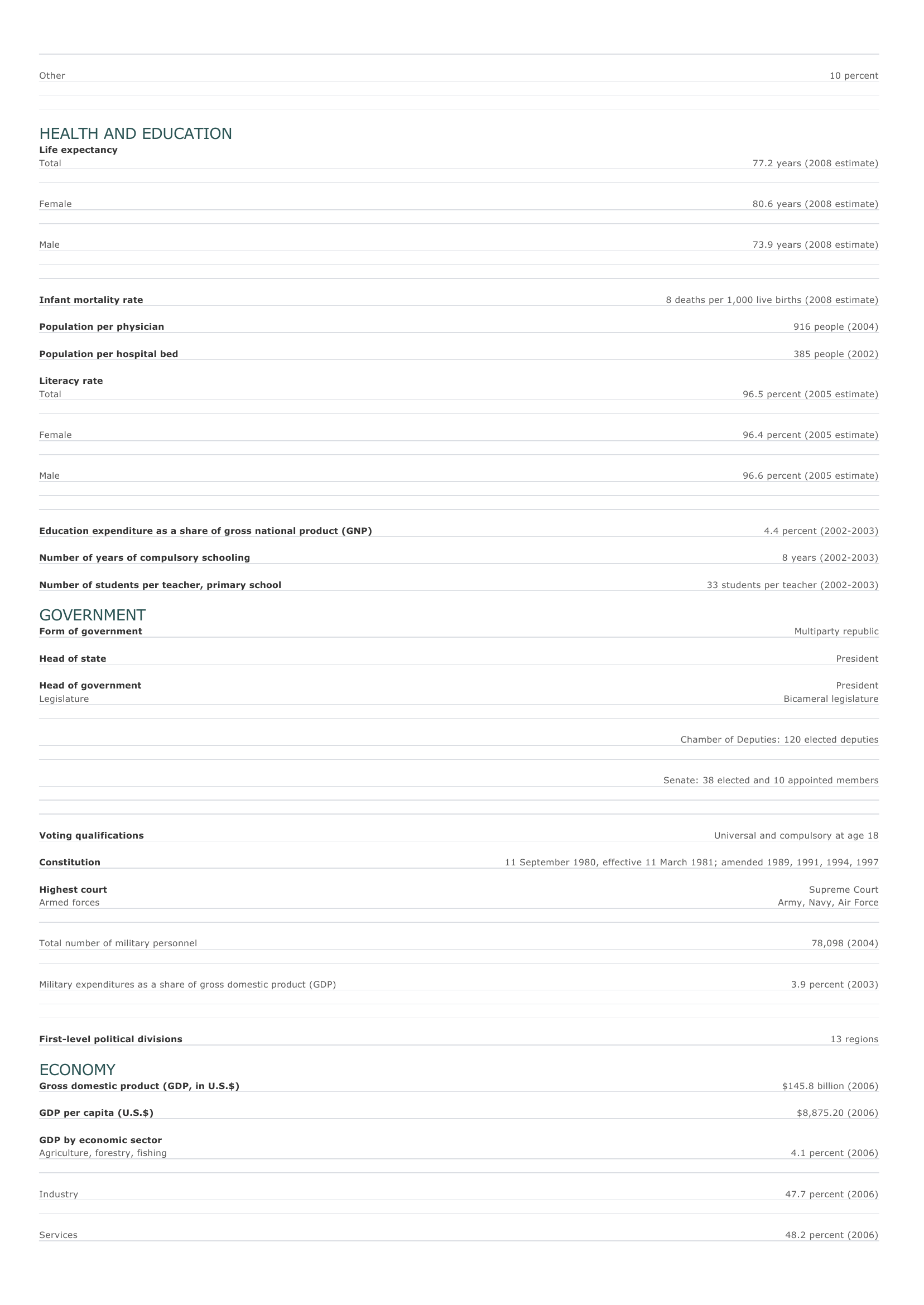Chile Facts and Figures. BASIC FACTS Official name Capital Area Republic of Chile Santiago 756,626 sq km 292,135 sq mi PEOPLE Population 16,432,536 (2008 estimate) Population growth Population growth rate 0.89 percent (2008 estimate) Projected population in 2025 18,521,153 (2025 estimate) Projected population in 2050 19,244,843 (2050 estimate) Population density 22 persons per sq km (2008 estimate) 57 persons per sq mi (2008 estimate) Urban/rural distribution Share urban 88 percent (2005 estimate) Share rural 12 percent (2005 estimate) Largest cities, with population Santiago 5,477,804 (2003 estimate) Puente Alto 627,263 (2006 estimate) Antofagasta 341,942 (2006 estimate) Viña del Mar 292,203 (2006 estimate) Valparaíso 276,474 (2006 estimate) Concepción 225,158 (2006 estimate) Ethnic groups Mestizo 93 percent Native American 3 percent European 2 percent O ther 2 percent Languages Spanish (official) Religious affiliations Roman Catholic 78 percent Protestant 3 percent Atheists 2 percent Nonreligious 7 percent O ther 10 percent HEALTH AND EDUCATION Life expectancy Total 77.2 years (2008 estimate) Female 80.6 years (2008 estimate) Male 73.9 years (2008 estimate) Infant mortality rate 8 deaths per 1,000 live births (2008 estimate) Population per physician 916 people (2004) Population per hospital bed 385 people (2002) Literacy rate Total 96.5 percent (2005 estimate) Female 96.4 percent (2005 estimate) Male 96.6 percent (2005 estimate) Education expenditure as a share of gross national product (GNP) Number of years of compulsory schooling Number of students per teacher, primary school 4.4 percent (2002-2003) 8 years (2002-2003) 33 students per teacher (2002-2003) GOVERNMENT Form of government Head of state Head of government Legislature Multiparty republic President President Bicameral legislature Chamber of Deputies: 120 elected deputies Senate: 38 elected and 10 appointed members Voting qualifications Constitution Highest court Armed forces Total number of military personnel Military expenditures as a share of gross domestic product (GDP) First-level political divisions Universal and compulsory at age 18 11 September 1980, effective 11 March 1981; amended 1989, 1991, 1994, 1997 Supreme Court Army, Navy, Air Force 78,098 (2004) 3.9 percent (2003) 13 regions ECONOMY Gross domestic product (GDP, in U.S.$) GDP per capita (U.S.$) GDP by economic sector Agriculture, forestry, fishing $145.8 billion (2006) $8,875.20 (2006) 4.1 percent (2006) I ndustry 47.7 percent (2006) Services 48.2 percent (2006) Employment Number of workers 6,581,001 (2006) Workforce share of economic sector Agriculture, forestry, fishing 13 percent (2005) I ndustry 23 percent (2005) Services 64 percent (2005) Unemployment rate 7.8 percent (2004) National budget (U.S.$) Total revenue $37,829 million (2006) Total expenditure $25,000 million (2006) Monetary unit 1 Chilean peso (Ch$), consisting of 100 centavos Agriculture Grapes, apples, wheat, sugar beets, tomatoes, potatoes, maize, wood and wood products, livestock Mining Copper, iron ore, petroleum, natural gas, nitrates, silver, gold, molybdenum Manufacturing Non-ferrous metals, food products, petroleum products, paper products, chemicals Major exports Copper, fishmeal, fruits and vegetables, paper and paper products, chemical products Major imports Machinery and transportation equipment, chemical and mineral products Major trade partners for exports United States, Japan, United Kingdom, China, and Brazil Major trade partners for imports Argentina, United States, Brazil, China, and Germany ENERGY, COMMUNICATIONS, AND TRANSPORTATION Electricity production Electricity from thermal sources 43.32 percent (2003 estimate) Electricity from hydroelectric sources 53.37 percent (2003 estimate) Electricity from nuclear sources Electricity from geothermal, solar, and wind sources 0 percent (2003 estimate) 3.31 percent (2003 estimate) Number of radios per 1,000 people 354 (1997) Number of telephones per 1,000 people 211 (2005) Number of televisions per 1,000 people 244 (2000 estimate) Number of Internet hosts per 10,000 people Daily newspaper circulation per 1,000 people Number of motor vehicles per 1,000 people Paved road as a share of total roads 138 (2003) 99 (1995 estimate) 136 (2003) 20 percent (2001) SOURCES Basic Facts and People sections Area data are from the statistical bureaus of individual countries. Population, population growth rate, and population projections are from the United States Census Bureau, International Programs Center, International Data Base (IDB) (www.census.gov). Urban and rural population data are from the Food and Agriculture Organization (FAO) of the United Nations (UN), FAOSTAT database (www.fao.org). Largest cities population data and political divisions data are from the statistical bureaus of individual countries. Ethnic divisions and religion data are largely from the latest Central Intelligence Agency (CIA) World Factbook and from various country censuses and reports. Language data are largely from the Ethnologue, Languages of the World, Summer Institute of Linguistics International (www.sil.org). Health and Education section Life expectancy and infant mortality data are from the United States Census Bureau, International Programs Center, International database (IDB) (www.census.gov). Population per physician and population per hospital bed data are from the World Health Organization (WHO) (www.who.int). Education data are from the United Nations Educational, Scientific and Cultural Organization (UNESCO) database (www.unesco.org). Government section Government, independence, legislature, constitution, highest court, and voting qualifications data are largely from various government Web sites, the latest Europa World Yearbook, and the latest Central Intelligence Agency (CIA) World Factbook. The armed forces data is from Military Balance. Economy section Gross domestic product (GDP), GDP per capita, GDP by economic sectors, employment, and national budget data are from the World Bank database (www.worldbank.org). Monetary unit, agriculture, mining, manufacturing, exports, imports, and major trade partner information is from the statistical bureaus of individual countries, latest Europa World Yearbook, and various United Nations and International Monetary Fund (IMF) publications. Energy, Communication, and Transportation section Electricity information is from the Energy Information Administration (EIA) database (www.eia.doe.gov). Radio, telephone, television, and newspaper information is from the United Nations Educational, Scientific and Cultural Organization (UNESCO) database (www.unesco.org). Internet hosts, motor vehicles, and road data are from the World Bank database (www.worldbank.org). Note Figures may not total 100 percent due to rounding. Microsoft ® Encarta ® 2009. © 1993-2008 Microsoft Corporation. All rights reserved.



